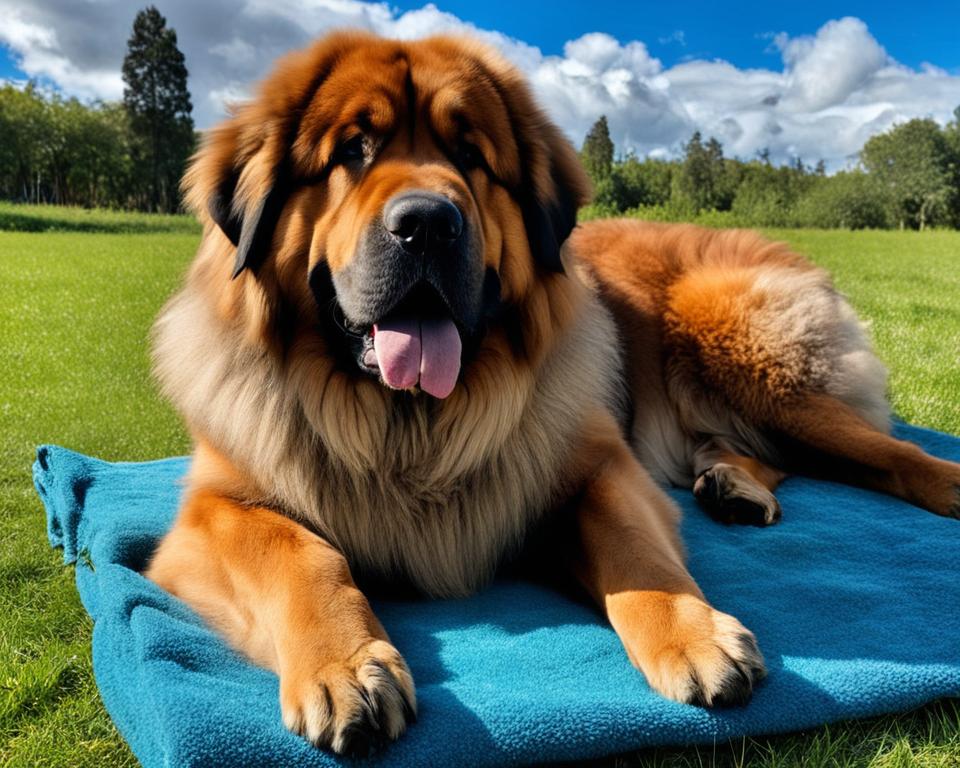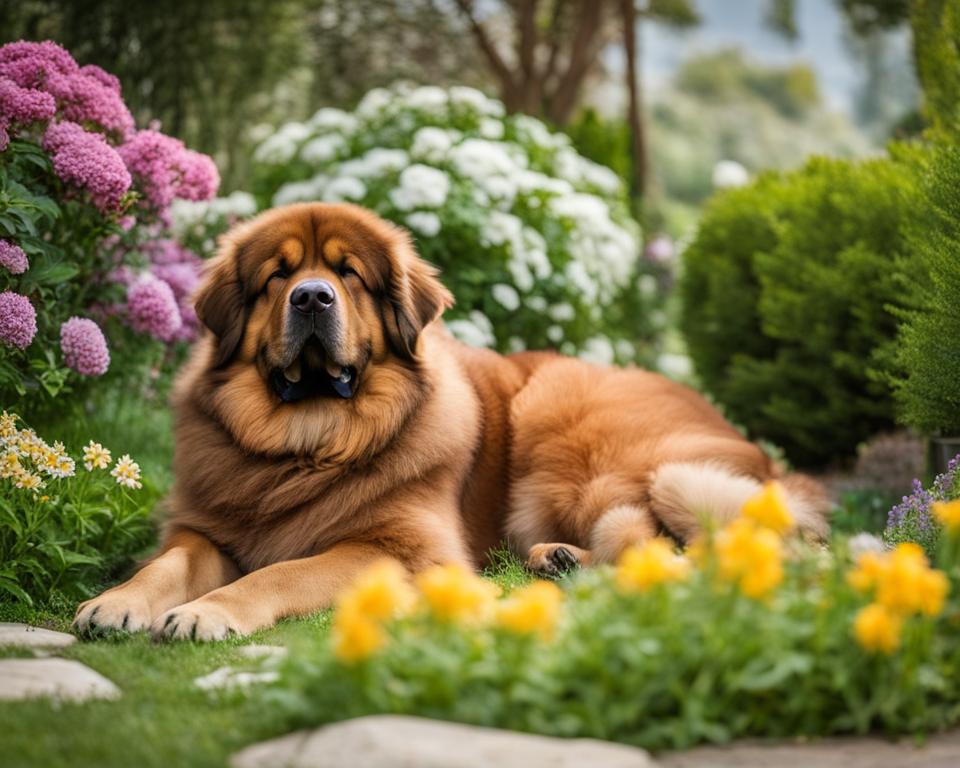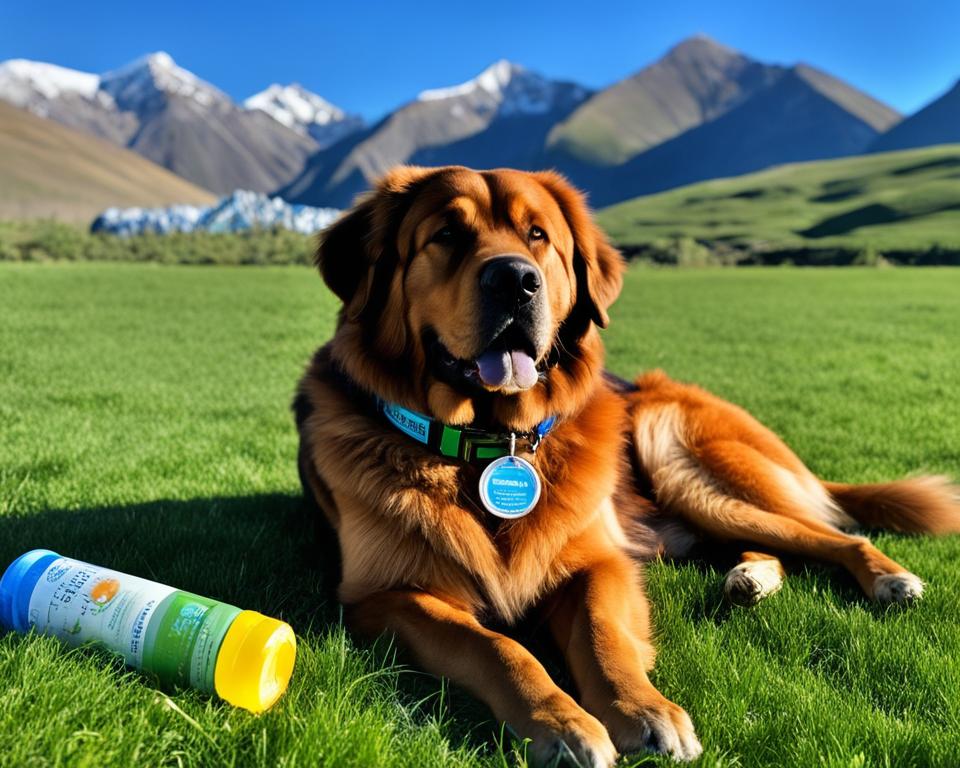Tibetan Mastiffs are unique and cherished companions, but they are also prone to allergies. Understanding how to manage these allergies is crucial to keeping your dog comfortable and symptom-free. By implementing effective allergy relief strategies, you can ensure that your Tibetan Mastiff maintains a high quality of life without the burden of allergic reactions. Let’s explore the tips and techniques for managing allergies in Tibetan Mastiffs.
Key Takeaways:
- Identify the types of allergies your Tibetan Mastiff may have: fleas, food, or environmental/seasonal allergens.
- Common symptoms of allergies in Tibetan Mastiffs include itchiness, skin inflammation, gastrointestinal issues, and respiratory problems.
- Consult with your veterinarian for diagnosis and treatment options tailored to your Tibetan Mastiff’s specific allergy.
- Environmental allergy management involves regular bathing, antihistamines, and fish oil supplements.
- Food allergy management may require a prescribed diet and dietary adjustments.
Understanding Allergy Types in Tibetan Mastiffs
Tibetan Mastiffs, like many other breeds, can experience various types of allergies that can cause a range of symptoms. By understanding these allergy types, you can better manage and prevent allergic reactions in your Tibetan Mastiff, ensuring their well-being and comfort.
Flea Allergy Dermatitis
Flea allergy dermatitis is the most common type of allergy in Tibetan Mastiffs. It is characterized by a hypersensitivity to fleabites. Even a single flea bite can trigger an intense allergic reaction in sensitive individuals. Symptoms of flea allergy dermatitis include severe itching, redness, inflammation, and skin lesions. Effective flea prevention and regular grooming practices are essential in managing this type of allergy.
Food Allergies
Tibetan Mastiffs can also develop food allergies, with certain proteins in their diet triggering allergic reactions. Common symptoms of food allergies include itching, gastrointestinal issues (such as vomiting or diarrhea), and skin problems. Identifying and eliminating the specific allergens through a strict food trial is crucial in managing food allergies in Tibetan Mastiffs.
Environmental/Seasonal Allergens
Environmental or seasonal allergens, such as pollen, dust, and mold spores, can affect Tibetan Mastiffs. These allergens can cause symptoms such as itching, sneezing, nasal discharge, and redness or inflammation of the skin. Minimizing exposure to these allergens through regular cleaning and maintaining a clean living environment can help prevent allergic reactions.
Understanding the different types of allergies that Tibetan Mastiffs can experience is the first step in effectively managing and preventing allergic reactions. By implementing suitable allergy-friendly care and preventive measures, you can ensure that your Tibetan Mastiff stays healthy, happy, and free from discomfort.
Symptoms of Allergies in Tibetan Mastiffs
Allergies in Tibetan Mastiffs can cause various symptoms that indicate an allergic response. It is crucial to recognize these signs and take prompt action to alleviate discomfort and prevent further complications.
- Itchiness: Tibetan Mastiffs with allergies may experience intense itching, leading to scratching and biting of the affected area.
- Hives: Raised, red welts on the skin, known as hives, can be a common symptom of allergic reactions.
- Swelling of the Face or Ears: Allergies can cause facial swelling, particularly around the eyes, nose, and ears.
- Red and Inflamed Skin: Skin redness and inflammation are often present in allergic dogs, especially in areas prone to allergen exposure.
- Diarrhea and Vomiting: Allergies can sometimes lead to gastrointestinal distress, resulting in diarrhea and vomiting.
- Sneezing: Tibetan Mastiffs with allergies may exhibit frequent sneezing as a response to irritants.
- Itchy Ears and Chronic Ear Infections: Ear itching and recurrent ear infections can be signs of allergic reactions in Tibetan Mastiffs.
- Itchy and Runny Eyes: Watery eyes, redness, and itchiness are common signs of ocular allergies in Tibetan Mastiffs.
- Constant Licking: Allergic dogs may lick their paws, belly, or other parts of their body excessively in an attempt to relieve itching.
Recognizing these symptoms is crucial in identifying allergic reactions in Tibetan Mastiffs. If you notice any of these signs, consult with your veterinarian for a proper diagnosis and to develop an effective allergy management plan.
Diagnosing and Treating Allergies in Tibetan Mastiffs
Diagnosing allergies in Tibetan Mastiffs can be challenging, but it is crucial for effective management. Your veterinarian will often rule out other conditions and may recommend allergy testing to identify the specific allergens affecting your Tibetan Mastiff. Treatment options for allergies vary depending on the type and severity of the allergies. They may include:
- Flea prevention measures
- Dietary changes to address food allergies
- Medications such as antihistamines or corticosteroids
- Using topical treatments or shampoos to relieve skin irritations
Working closely with your veterinarian is key to finding the most suitable treatment plan for your Tibetan Mastiff. Together, you can develop a comprehensive approach that aims to alleviate Tibetan Mastiff allergy symptoms and improve your dog’s overall well-being.
Comparison of Treatment Options for Tibetan Mastiff Allergies
| Treatment Option | Description |
|---|---|
| Flea prevention measures | Regular use of flea preventatives to reduce the risk of flea allergies and infestation. |
| Dietary changes | Modification of the dog’s diet to eliminate potential food allergens and identify trigger ingredients. |
| Medications | Prescription of antihistamines or corticosteroids to manage allergy symptoms and reduce inflammation. |
| Topical treatments | Application of topical creams or shampoos to soothe and alleviate skin irritations caused by allergies. |

By employing these treatment options, you can effectively manage and minimize allergic reactions in your Tibetan Mastiff. However, it is important to consult with your veterinarian for personalized guidance based on your dog’s specific needs and condition. Together, you can create a tailored approach to alleviate Tibetan Mastiff allergy symptoms and provide your beloved companion with optimal comfort and care.
Environmental Allergy Management for Tibetan Mastiffs
Environmental allergies can significantly impact the well-being of Tibetan Mastiffs. To effectively manage these allergies and provide relief for your furry companion, consider the following strategies:
1. Regular Bathing
To remove allergens from your dog’s skin, regular bathing is essential. Use a gentle, oatmeal-based shampoo that is specifically formulated for dogs. This will help soothe and cleanse the skin while reducing itching and irritation. A clean coat can significantly alleviate the symptoms of environmental allergies.
2. Antihistamines
If your Tibetan Mastiff experiences symptoms of environmental allergies, such as itching or sneezing, your veterinarian may prescribe antihistamines. These medications can help control allergic reactions and provide relief. Follow your vet’s instructions regarding the dosage and frequency of administration for optimal results.
3. Fish Oil Supplements
Adding fish oil supplements to your Tibetan Mastiff’s diet can have beneficial effects on allergy management. Fish oil contains omega-3 fatty acids, which have anti-inflammatory properties and can help reduce itching and inflammation associated with allergies. Consult with your veterinarian to determine the appropriate dosage and type of fish oil for your dog’s specific needs.
By implementing these strategies, you can improve your Tibetan Mastiff’s quality of life by managing their environmental allergies effectively.
| Allergy Management Strategies | Benefits |
|---|---|
| Regular Bathing | Removes allergens from the skin and reduces itching |
| Antihistamines | Controls allergic reactions and provides relief |
| Fish Oil Supplements | Reduces itching and inflammation associated with allergies |

Implementing these allergy management strategies will help alleviate the discomfort caused by environmental allergies in Tibetan Mastiffs. However, it’s important to consult with your veterinarian to determine the best course of action for your individual dog’s needs. Each Tibetan Mastiff is unique, and a tailored approach to allergy management is essential for their overall well-being.
Food Allergy Management for Tibetan Mastiffs
Food allergies can cause significant discomfort for Tibetan Mastiffs. To effectively manage these allergies and provide relief for your furry companion, a food trial may be recommended. This involves feeding your Tibetan Mastiff a prescribed diet of a single protein source and carbohydrate for a minimum of 12 weeks, closely monitoring for any improvement in symptoms.
A food trial aims to identify the specific food allergen causing the reaction. By eliminating potential allergens and introducing a limited ingredient diet, you can pinpoint the source of the allergic response and make necessary dietary adjustments. This approach helps to alleviate symptoms and improve your Tibetan Mastiff’s overall well-being.
Working closely with your veterinarian is essential throughout the food trial process. They can guide you in selecting the appropriate protein and carbohydrate sources for the trial, considering your Tibetan Mastiff’s nutritional needs. They may also suggest hypoallergenic or veterinary-prescribed diets specifically formulated for dogs with food allergies.
Benefits of a Food Trial for Tibetan Mastiffs
A food trial offers several benefits in managing food allergies in Tibetan Mastiffs:
- Identification: By eliminating potential allergens and introducing a limited ingredient diet, a food trial helps identify the specific allergen causing the reaction.
- Relief: Once the allergen is identified and eliminated from the diet, symptoms such as itching and gastrointestinal issues can significantly improve or even disappear, providing much-needed relief for your Tibetan Mastiff.
- Precise Diet Adjustment: If the initial food trial does not lead to symptom improvement, further dietary adjustments can be made with the guidance of your veterinarian. They may recommend different protein sources or carbohydrate options to find the most suitable diet for your Tibetan Mastiff’s specific needs.
- Long-Term Management: Through the food trial process, you can establish a long-term diet plan for your Tibetan Mastiff that avoids the specific allergen, minimizing the likelihood of future allergic reactions.
Monitoring and Maintaining a Food Trial
To ensure the success of a food trial and manage food allergies in Tibetan Mastiffs effectively, diligent monitoring and strict adherence to the prescribed diet are crucial. Here are some guidelines to follow:
- Keep a detailed journal: Record your Tibetan Mastiff’s daily food intake, any symptoms or changes observed, and the timing of these occurrences. This journal will help identify patterns and provide valuable information for your veterinarian.
- Avoid treats and table scraps: During the food trial period, it is essential to eliminate any additional food sources, including treats and table scraps, as they may contain potential allergens that can interfere with the trial’s accuracy.
- Prevent access to other foods: Ensure your Tibetan Mastiff cannot access other animals’ food, garbage, or outdoor items that could contain potential allergens.
- Follow veterinary guidance: Consult your veterinarian at regular intervals during the trial. They may recommend additional diagnostic tests or adjustments to the diet based on your Tibetan Mastiff’s progress and response to the trial.
Bathing and Grooming Tips for Allergy Management
Regular bathing and grooming can play a vital role in managing allergies in Tibetan Mastiffs. By following proper hygiene practices, you can provide allergy relief and promote a healthy coat and skin for your furry companion.
Avoidance of Allergens
When bathing your Tibetan Mastiff, use a dog-specific shampoo designed to remove allergens from the coat and skin. Aim to bathe your dog at least one to two times a week to ensure thorough cleaning. It is essential to use high-quality products that are recommended by your veterinarian to avoid further irritation or adverse reactions.
Grooming for Allergy Prevention
Regular grooming helps prevent allergens from accumulating in your Tibetan Mastiff’s coat. Keep their coat well-groomed and free from mats to minimize the presence of allergens and reduce the risk of allergic reactions. Brushing your dog’s coat regularly also helps distribute natural oils, promoting skin health.
Additionally, consider using grooming products that are specifically formulated for allergy relief. These products can help soothe your Tibetan Mastiff’s skin and alleviate any discomfort caused by allergies.
Paw Care and Maintenance
Regularly inspect and clean your Tibetan Mastiff’s paws to remove any allergens or irritants they may have picked up while outdoors. Keep the hair between their paw pads trimmed to prevent the accumulation of allergens and reduce the risk of skin irritations.
Consultation with a Professional Groomer
If you find it challenging to manage your Tibetan Mastiff’s allergies through regular bathing and grooming practices, consider seeking assistance from a professional groomer. Professional groomers are experienced in handling dogs with allergies and can provide valuable guidance on the most suitable grooming techniques and products for your Tibetan Mastiff’s specific needs.
By implementing these bathing and grooming tips, you can effectively manage allergies in your Tibetan Mastiff and ensure their overall well-being and comfort.
Preventive Measures for Tibetan Mastiff Allergies
Taking proactive measures is crucial for preventing and managing allergies in Tibetan Mastiffs. By implementing preventive strategies, you can significantly reduce the incidence and severity of allergic reactions in your beloved companion. Here are some essential preventive measures for Tibetan Mastiff allergy management:
1. Regular flea prevention: Fleas are a common cause of allergies in Tibetan Mastiffs. To prevent flea allergies, make sure to use flea preventatives recommended by your veterinarian throughout the year. These products help control and eliminate fleas, ensuring your dog remains protected and comfortable.
2. Maintain an allergen-free environment: Keeping your Tibetan Mastiff’s living environment clean and free from allergens is crucial, especially during peak allergy seasons. Regularly vacuuming your home, washing your dog’s bedding, and minimizing exposure to potential triggers like pollen or dust can help minimize allergic reactions.
3. Provide a balanced diet: A well-balanced and nutritious diet tailored to your Tibetan Mastiff’s specific needs is essential for overall health and reducing the risk of food allergies. Consult with your veterinarian to determine the most suitable diet for your dog, considering any known allergies or sensitivities.
By implementing these preventive measures, you can effectively minimize the impact of allergies on your Tibetan Mastiff’s well-being. Consistent flea prevention, a clean living environment, and a healthy diet are key components of successfully managing and preventing allergies in Tibetan Mastiffs.
FAQ
What are the major types of allergies that Tibetan Mastiffs can experience?
Tibetan Mastiffs can experience fleas, food, and environmental/seasonal allergies.
What are the common symptoms of allergies in Tibetan Mastiffs?
Common symptoms of allergies in Tibetan Mastiffs include itchiness, hives, swelling, red and inflamed skin, diarrhea, vomiting, sneezing, itchy ears, chronic ear infections, itchy and runny eyes, and constant licking.
How are allergies diagnosed and treated in Tibetan Mastiffs?
Allergies in Tibetan Mastiffs are diagnosed through ruling out other conditions and may require allergy testing. Treatment options vary depending on the type and severity of the allergies and may include flea prevention, dietary changes, medications, and topical treatments or shampoos.
How can I manage environmental allergies in my Tibetan Mastiff?
Strategies for managing environmental allergies in Tibetan Mastiffs include regular bathing with an oatmeal-based shampoo, antihistamines prescribed by a vet, and adding fish oil supplements to the diet.
How can I manage food allergies in my Tibetan Mastiff?
Food allergies in Tibetan Mastiffs can be managed through a food trial of a prescribed diet, closely monitoring symptoms, and working with a veterinarian to identify and eliminate specific allergens.
What are some bathing and grooming tips for managing allergies in Tibetan Mastiffs?
Regular bathing with a dog-specific shampoo and keeping the coat well-groomed can help remove allergens and prevent further irritation.
What preventive measures can I take to reduce the incidence and severity of allergies in my Tibetan Mastiff?
Preventive measures include regular flea prevention and control, maintaining a clean environment, and providing a balanced and nutritious diet.

Leave a Reply